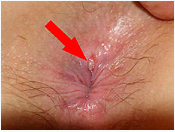Dr. Kaushik Navale - Fissure Treatment in Pimpri Chinchwad, Pune

What is Fissure in ano / Anal Fissure –
Fissure is a linear ulcer or crack in the mucocutaneous lining of the lower anal canal. An anal fissure is a small tear or crack in the lining of the anus, often caused by passing hard stools or straining during bowel movements. Symptoms include pain, bleeding, and itching during bowel movements.
Types Of Fissure – Superficial And Deep
Superficial anal fissures look like a paper cut, and generally get self-heal within a week. However, some anal fissures become chronic and deep and will not heal. The most common cause of non-healing is spasming of the internal anal sphincter muscle which results in impaired blood supply to the anal mucosa.
Main Features –
– Pain in anal area which increases after passing stools,
– Severe cutting pains, patient prefers to remain constipated rather than going through the agony of pain.
– Bleeding – stools are streaked with blood.
– Burning sensation at anal opening.
– Constipation – pain either initiated or aggrevated with passing stools sotendency to avoid going to stools so constipation.
– Swelling – a large sentinel tag causes painful external swelling.
– Urinary symptoms – some patients may develop urinary retention, painful urination, increased frequency.
Causes –
– Constipation – passing of large, hard stools,
– Prolonged diarrhoea,
– Child birth trauma in women,
– Poor toileting in young children.
Treatment – Treatment is given according to type of fissure.
– Different types of Internal medicines, medicated ghritas are given for healing of cuts.
– Ayurvedic stool softerners are given to avoid hardening of stools.
– Extenal medicinal sitz bath are provided for killing of pains and for healing of cuts.
– Fibre diet is suggested to improve bad toilet habits.
Superficial anal fissures generally get healed within a week. However, some anal fissures become chronic and deep and will not heal. The most common cause of non healing is spasming of the internal anal sphincter muscle which results in impaired blood supply to the anal mucosa.
In such cases of anal stricture, anal dilatation under anaesthesia is suggested to relieve sphincter muscle spasm.
